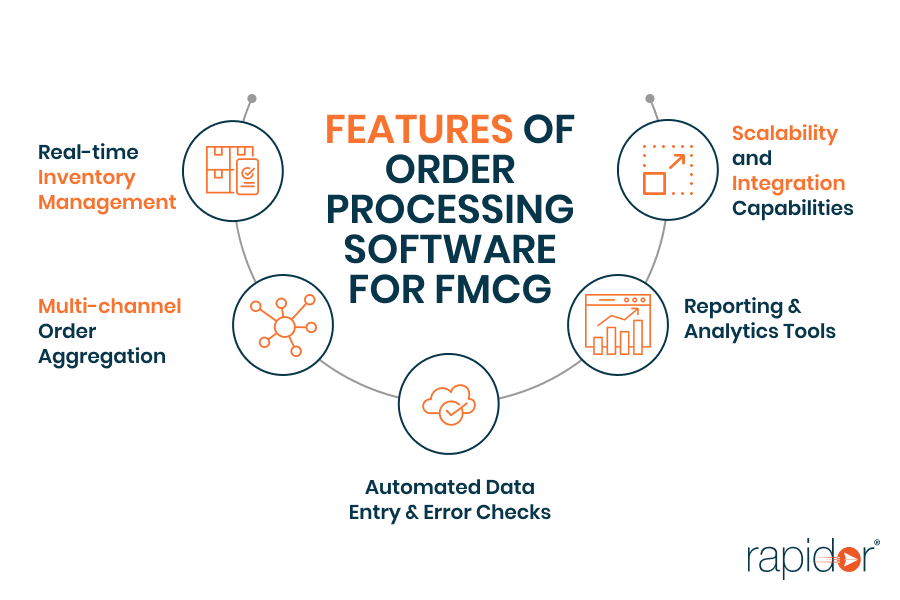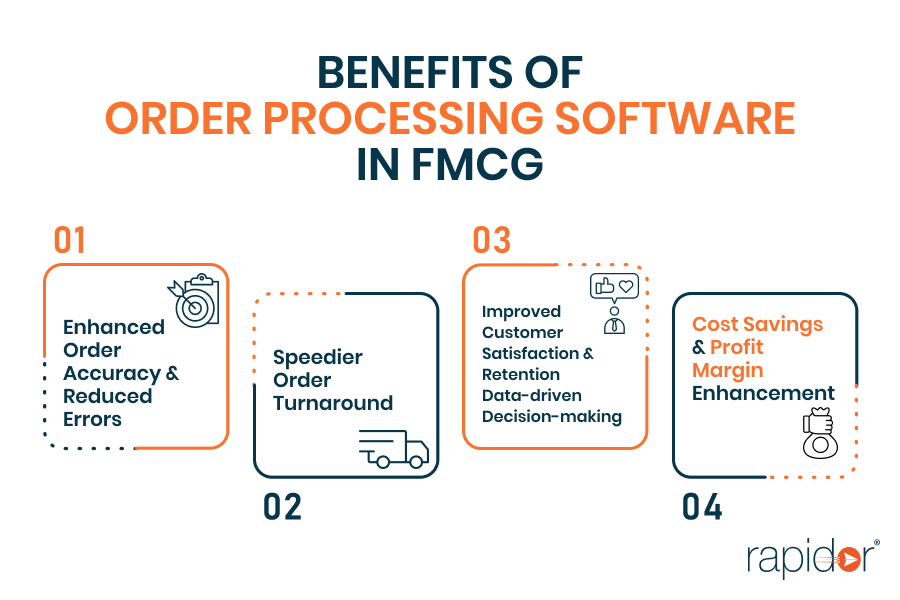The Fast-Moving Consumer Goods (FMCG) sector in India has witnessed remarkable growth, driven by consumer-driven demand and favorable government initiatives. With a market expected to reach US$ 220 billion by 2025, the industry has become a key contributor to India’s GDP. However, this dynamic sector faces unique challenges, including managing growing demand, streamlining operations, and meeting diverse customer expectations.
Importance of Efficient Order Processing
Efficient order processing emerges as a crucial aspect for FMCG companies to navigate these challenges successfully. Timely and accurate order fulfillment ensures customer satisfaction, retention, and increased profitability.
This blog delves into the world of FMCG order processing, exploring its specific challenges, the role of technology, key features to consider in order processing software, and the benefits of streamlined processes. Discover how integrating advanced software solutions can elevate the efficiency and competitiveness of FMCG businesses in this ever-evolving market landscape.
Understanding FMCG Order Processing
What is Order Processing?
Order processing refers to the series of steps involved in fulfilling customer orders for FMCG products. It encompasses receiving and verifying orders, managing inventory, packing, shipping, and invoicing. Timely and accurate order processing is essential to meet customer demands, reduce lead times, and ensure smooth logistics operations.
Specific Challenges in FMCG Order Processing
The FMCG sector faces unique challenges in order processing due to its fast-paced nature and diverse product range. Managing large order volumes, coordinating with multiple distribution channels, and handling perishable products with short shelf lives pose significant challenges. Order accuracy, inventory management, and order tracking are critical aspects to address. Moreover, during peak seasons or promotions, managing sudden spikes in orders can lead to bottlenecks and delays. Overcoming these challenges is crucial to maintain customer satisfaction and competitive advantage.
Importance of Streamlining Orders in FMCG
Streamlining order processing is vital for FMCG companies to remain efficient and competitive in today’s market. Efficient order processing enhances the customer experience by ensuring faster order fulfillment and on-time deliveries. It minimizes errors, reducing the chances of order cancellations or returns. Moreover, streamlined processes optimize inventory levels, reducing carrying costs and stockouts. This, in turn, enhances supply chain efficiency and reduces operational costs. By embracing technology and automation, FMCG businesses can achieve seamless order processing, leading to improved customer satisfaction, increased sales, and a stronger market position.
The Role of Technology in FMCG Order Management
The Evolution of FMCG Order Management
FMCG order management has evolved significantly with advancements in technology. From manual record-keeping and traditional paper-based processes, the industry has transitioned to digitized systems. The integration of software solutions has streamlined order processing, inventory management, and logistics. Real-time data visibility and analytics empower decision-makers to make data-driven choices, enhancing operational efficiency and customer service.
Benefits of Incorporating Technology
Incorporating technology in FMCG order management brings numerous benefits. Automation reduces manual errors and accelerates order processing, leading to faster order fulfillment and timely deliveries. Real-time inventory tracking ensures optimum stock levels, minimizing the risk of stockouts or overstocking. Moreover, technology-enabled order management enhances collaboration with suppliers and distributors, streamlining communication and increasing supply chain visibility. The ability to analyze data and customer preferences also helps businesses tailor offerings and promotions, fostering stronger customer relationships.
Software vs. Manual Processing: A Comparative Analysis
Comparing software-driven order management with manual processing highlights the superiority of technology in the FMCG sector. Manual processing is prone to errors, often leading to delayed order processing and customer dissatisfaction. It relies on manual data entry and lacks real-time tracking, making it challenging to manage inventory effectively. In contrast, order management software offers automation, accuracy, and speed.
It enables seamless order tracking, stock level monitoring, and efficient data analysis, contributing to better decision-making. Software solutions also integrate with other business systems, promoting smooth workflow and data sharing across departments. The time and cost savings achieved through technology adoption make it a strategic investment for FMCG companies seeking to optimize their order management processes.

Features to Look For in an Order Processing Software for FMCG
Real-time Inventory Management
A robust order processing software should offer real-time inventory management, providing instant visibility into stock levels and product availability. This feature allows businesses to optimize inventory, avoid stockouts, and prevent excess inventory costs. Real-time updates enable timely reorder decisions, ensuring uninterrupted supply to meet customer demands efficiently.
Multi-channel Order Aggregation
An effective order processing software must support multi-channel order aggregation, seamlessly consolidating orders from various sales channels, such as online marketplaces, brick-and-mortar stores, and distributors. This feature centralizes order processing, simplifying fulfillment and reducing order handling complexity. It enables businesses to manage orders from different sources in a unified platform, leading to enhanced order accuracy and customer satisfaction.
Automated Data Entry & Error Checks
Automated data entry minimizes manual intervention, reducing the risk of errors and ensuring accurate order processing. An ideal order processing software should feature automated data capture from multiple sources, eliminating redundant data entry tasks. Additionally, it should include error checks and validation mechanisms to identify and rectify order discrepancies, enhancing data accuracy and order efficiency.
Reporting & Analytics Tools
Advanced reporting and analytics tools are essential in an order processing software for FMCG. These tools provide insights into order trends, sales performance, inventory levels, and customer behavior. Businesses can use these data-driven insights to optimize operations, plan promotions, and identify growth opportunities. Visualized reports and analytics empower decision-makers to make informed choices, ensuring continuous improvements in order management and overall business performance.
Scalability and Integration Capabilities
Scalability is crucial as FMCG businesses experience fluctuations in demand and expansion. An order processing software should be scalable to accommodate growing order volumes and additional sales channels. Furthermore, seamless integration with existing systems such as ERP, CRM, and inventory management ensures smooth data flow and minimizes manual data transfer. This integration capability streamlines processes, reduces duplicate data entry, and enhances overall operational efficiency.

Benefits of Streamlined Order Processing in FMCG using Software
Enhanced Order Accuracy & Reduced Errors
Streamlined order processing through software significantly improves order accuracy by automating data entry and validation. With reduced manual intervention, the chances of errors and order discrepancies are minimized, leading to higher customer satisfaction and fewer returns or complaints. The precision in order fulfillment builds trust with customers, enhancing brand reputation and fostering long-term relationships.
Speedier Order Turnaround
Efficient order processing software expedites order fulfillment processes, reducing the time between order placement and delivery. Automation accelerates tasks like order confirmation, invoicing, and dispatch, enabling faster processing and shipment. This swift order turnaround enhances customer experience, especially in today’s fast-paced market where timely deliveries are crucial to meet customer expectations.
Improved Customer Satisfaction & Retention
Streamlined order processing leads to improved customer satisfaction due to accurate and timely order deliveries. Satisfied customers are more likely to become repeat buyers, leading to higher customer retention rates. Happy customers also tend to spread positive word-of-mouth, attracting new customers to the business. Improved customer satisfaction and retention contribute to sustainable business growth and increased market competitiveness.
Data-driven Decision-making
An order processing software generates valuable data and analytics that offer insights into customer behavior, order trends, and product performance. This data-driven approach empowers businesses to make informed decisions based on real-time information. From inventory management to marketing strategies, data-driven decision-making enables businesses to optimize processes, identify opportunities, and address challenges effectively, ultimately boosting overall performance and profitability.
Cost Savings & Profit Margin Enhancement
Streamlined order processing software optimizes operational efficiency, reducing manual effort, and eliminating redundancies. The automation of tasks leads to cost savings by reducing labor and resource expenses. Additionally, accurate inventory management prevents overstocking and stockouts, minimizing carrying costs and lost sales. With improved efficiency and reduced operational costs, businesses can enhance profit margins and allocate resources strategically for growth initiatives.
Implementation & Best Practices
Assessing Business Requirements
Before implementing an order processing software, businesses must assess their specific needs and processes. Identifying pain points, volume of orders, integration requirements, and scalability expectations are crucial to choose the right solution. Understanding business requirements ensures that the selected software aligns with the organization’s goals and enhances operational efficiency.
Choosing the Right Software Vendor
Selecting the appropriate software vendor is critical for successful implementation. Businesses should evaluate vendors based on their experience, reputation, customer support, and ability to meet specific FMCG industry needs. Conducting thorough research, seeking recommendations, and reviewing customer testimonials help in making an informed decision about the best-fit vendor.
Training & Change Management
Proper training and change management are essential for a smooth transition to the new order processing system. Employees should be adequately trained to effectively utilize the software’s features. Additionally, change management strategies should be employed to help the workforce adapt to the new processes, fostering a positive attitude towards the software adoption.
Regular System Updates & Maintenance
Regular system updates and maintenance are crucial to ensure the software’s optimal performance and security. Vendors often release updates to improve functionality and address potential issues. Staying up-to-date with these updates and performing regular maintenance checks prevent system glitches, data breaches, and downtime, ensuring uninterrupted order processing operations.
Evaluating Performance Metrics
After implementation, businesses must continuously monitor and evaluate key performance metrics related to order processing. Metrics such as order accuracy, fulfillment time, customer satisfaction, and error rates provide insights into the software’s effectiveness. Analyzing these metrics enables businesses to identify areas for improvement and make necessary adjustments to maximize the software’s benefits.
Conclusion
In conclusion, efficient order processing is paramount for FMCG businesses to stay competitive in a rapidly evolving market. By embracing advanced order processing software, companies can streamline operations, enhance customer satisfaction, and achieve substantial cost savings. The future of the FMCG sector lies in leveraging technology to meet increasing demands and deliver exceptional customer experiences.
FAQ
Q1: What is FMCG order processing?
A1: FMCG order processing refers to the end-to-end management of orders, from the moment they are placed to their fulfillment and delivery. It involves various tasks such as order entry, inventory management, order tracking, and invoicing.
Q2: Why is streamlined order processing crucial for FMCG businesses?
A2: Streamlined order processing ensures timely and accurate order fulfillment, leading to enhanced customer satisfaction and retention. It also reduces errors, improves efficiency, and enables data-driven decision-making, which is essential for staying competitive in the FMCG sector.
Q3: How can technology improve FMCG order management?
A3: Technology can automate and optimize various order processing tasks, leading to faster turnaround times, real-time inventory management, and improved data accuracy. Advanced software also provides valuable analytics and reporting tools for better decision-making.
Q4: What features should one look for in order processing software for FMCG?
A4: Key features include real-time inventory management, multi-channel order aggregation, automated data entry, reporting and analytics tools, and scalability with integration capabilities. These features ensure seamless and efficient order processing operations.
Q5: How can businesses implement order processing software effectively?
A5: Implementing order processing software involves assessing business requirements, choosing the right software vendor, providing proper training to employees, conducting regular system updates and maintenance, and evaluating performance metrics to optimize operations and achieve desired outcomes.


